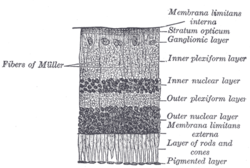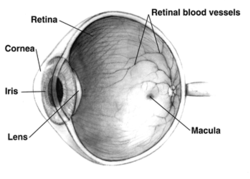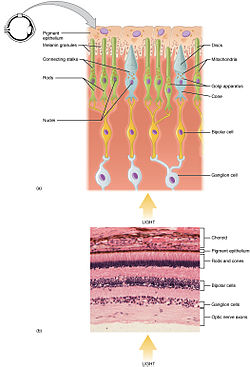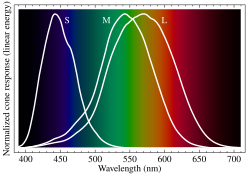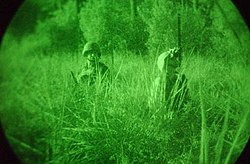elements composing the layer of rods and cones (Jacob's membrane) in the retina of the eye are of two kinds, rod cells and cone cells, the former being...
1 KB (131 words) - 21:06, 17 October 2023
limitans externa, through which they are continuous with the cones of the layer of rods and cones. They do not present any cross-striation, but contain a pyriform...
2 KB (301 words) - 01:53, 7 April 2020
Retina (redirect from Retinal layers)
cells, bipolar cells, and horizontal cells Outer plexiform layer – projections of rods and cones ending in the rod spherule and cone pedicle, respectively...
84 KB (9,305 words) - 18:28, 16 July 2025
Photoreceptor cell (redirect from Rods and cones)
photoreceptor cells are rods and cones, each contributing information used by the visual system to form an image of the environment, sight. Rods primarily mediate...
26 KB (2,939 words) - 18:31, 17 May 2025
pigments. In cones, these disks are attached to the outer membrane, whereas they are pinched off and exist separately in rods. Neither rods nor cones divide...
17 KB (1,892 words) - 19:34, 17 July 2025
microns in diameter and 100 microns long. Rods are not all morphologically the same; in mice, rods close to the outer plexiform synaptic layer display a reduced...
14 KB (1,753 words) - 09:32, 12 March 2025
Macula (redirect from Macula of the retina)
only one type of rod, but the rods are more sensitive than the cones, so in dim light, they are the dominant photoreceptors active, and without information...
14 KB (1,449 words) - 20:50, 22 June 2024
macula. The histological examination of the eyes of one such patient showed that the outer nuclear layer of cones and rods had disappeared completely, whereas...
11 KB (1,318 words) - 20:17, 4 May 2025
Visual acuity (redirect from Sharpness of vision)
reciprocal of degrees visual angle, divided by the foveal value Original figure in Østerberg, G. (1935). "Topography of the layer of rods and cones in the...
62 KB (7,723 words) - 20:58, 6 April 2025
Sensory nervous system (redirect from Organs of sense)
concentrations and ratio of rods to cones is strongly correlated with whether an animal is diurnal or nocturnal. In humans, rods outnumber cones by approximately...
30 KB (3,361 words) - 16:00, 26 April 2025
photosensitive region of the retina. The pigmented layer is continuous over choroid, ciliary body and iris while the nervous layer terminates just before...
2 KB (211 words) - 19:21, 4 January 2023
Dua's layer, according to a 2013 paper by Harminder Singh Dua's group at the University of Nottingham, is a layer of the cornea that had not been detected...
12 KB (1,497 words) - 06:48, 15 February 2024
Fovea centralis (section Angular size of foveal cones)
appearance than cones elsewhere. These cones are very densely packed (in a hexagonal pattern). Starting at the outskirts of the fovea, however, rods gradually...
26 KB (3,013 words) - 18:55, 25 May 2025
Lens (vertebrate anatomy) (redirect from Lens of the eye)
cells make up the majority of the lens. These cells vary in architecture and are arranged in concentric layers. New layers of cells are recruited from a...
53 KB (6,543 words) - 13:05, 2 July 2025
Retina bipolar cell (redirect from Bipolar cell of the retina)
either rods or cones, or both rods and cones, though they are generally designated rod bipolar or cone bipolar cells. There are 11 distinct forms of cone bipolar...
7 KB (823 words) - 18:59, 17 July 2025
Russell Foster (category Commanders of the Order of the British Empire)
Foster studied light entrainment on mice without cones or both rods and cones. Mice without cones or without both photoreceptive cells (rd/rd cl allele)...
15 KB (1,486 words) - 00:26, 8 March 2025
million rods. Cones are found primarily in the center (or fovea) of the retina. There are three types of cones that differ in the wavelengths of light they...
59 KB (6,928 words) - 21:06, 22 May 2025
Eye (section Rods and cones)
retina. Cones are responsible for colour vision. They require brighter light to function than rods require. In humans, there are three types of cones, maximally...
59 KB (7,524 words) - 02:12, 21 July 2025
(Latin: flat portion) is part of the ciliary body in the uvea (or vascular tunic, the middle layer of the three layers that comprise the eye). It is about...
966 bytes (110 words) - 16:50, 15 October 2024
Retinal ganglion cell (redirect from Ganglion cell of the retina)
about 100 rods and cones. However, these numbers vary greatly among individuals and as a function of retinal location. In the fovea (center of the retina)...
30 KB (3,681 words) - 05:13, 12 May 2025
Night vision (redirect from Rod vision)
pupils may expand to the physical limit of the eyelids), more rods than cones (or rods exclusively) in the retina, and a tapetum lucidum. Enhanced intensity...
23 KB (2,715 words) - 18:24, 24 May 2025
rods and cones, the ipRGCs respond more sluggishly and signal the presence of light over the long term. They represent a very small subset (~1%) of the...
27 KB (3,120 words) - 16:02, 26 May 2025
External limiting membrane (redirect from Outer limiting layer)
is one of the ten distinct layers of the retina of the eye. It has a network-like structure and is situated at the bases of the rods and cones. Retina...
2 KB (108 words) - 12:33, 22 October 2023
Color (category Articles with Internet Encyclopedia of Philosophy links)
wavelengths around 450 nm; cones of this type are sometimes called short-wavelength cones or S cones (or misleadingly, blue cones). The other two types are...
59 KB (7,053 words) - 01:25, 13 July 2025
layer, where amacrine cells synapse with retinal ganglion cells. The synapses in the outer plexiform layer are between the rod cell endings or cone cell...
2 KB (142 words) - 21:13, 21 November 2021
into rod bipolars and cone bipolars. The inner processes of the rod bipolars run through the inner plexiform layer and arborize around the bodies of the...
3 KB (344 words) - 14:09, 1 November 2023
Optic disc (redirect from Physiologic blind spot of Mariotte)
or optic nerve head is the point of exit for ganglion cell axons leaving the eye. Because there are no rods or cones overlying the optic disc, it corresponds...
14 KB (1,608 words) - 10:33, 18 July 2025
Mammalian eye (redirect from Eyes of mammals)
from cone vision to rod vision is why the darker conditions become, the less color objects seem to have. The differences between rods and cones are useful;...
22 KB (2,758 words) - 17:51, 16 July 2025
delineating stratigraphic layers is related to the size of the cone tip, with typical cone tips having a cross-sectional area of either 10 or 15 cm2, corresponding...
9 KB (1,102 words) - 03:17, 16 April 2025
Color vision (redirect from Sense of colour)
555 nm. Between these regions, mesopic vision comes into play and both rods and cones provide signals to the retinal ganglion cells. The shift in color...
65 KB (7,957 words) - 02:57, 18 July 2025

